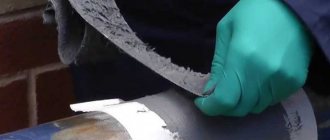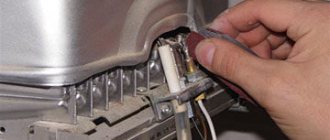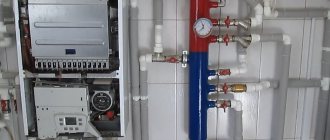Water supply and sewerage systems of a residential building and apartment consist of pipes connected to each other in various ways, including fittings. Over time, a leak may form at the pipe junction. If the fault is not corrected in time, flooding may occur in the apartment, which will lead to the need for repairs. There are several ways to eliminate leaks at pipe joints, which will be discussed in this article.
Water leakage at the pipe connection
Working with a threaded connection
Eliminating a leak on a home line must begin with finding the exact location of the accident. First of all, you need to check all threaded connections if the pipes are metal. It happens that it is enough to simply tighten the fitting using a special (gas) wrench.
But, if the actions did not lead to success, then you need to try changing the tow. To do this, you need to unscrew the coupling halfway and clean the threads from the old winding. Then wind up fresh tow and screw the fitting into place. To make the connection stronger, you can apply a little thick paint to the winding.
An experienced plumber does not need to turn off the water supply for such an operation. A novice, working under pressure, risks provoking an even bigger accident. Because any delay threatens to break the weakened connection due to high water pressure in the pipes.
In areas with threads, the metal inevitably becomes thinner. And if the pipe is “leaky” in this place, then the situation can only be corrected by completely replacing the connection. To do this, a new pipe is selected and a partial dismantling of the pipeline is carried out. Having previously turned off the water supply in this area.
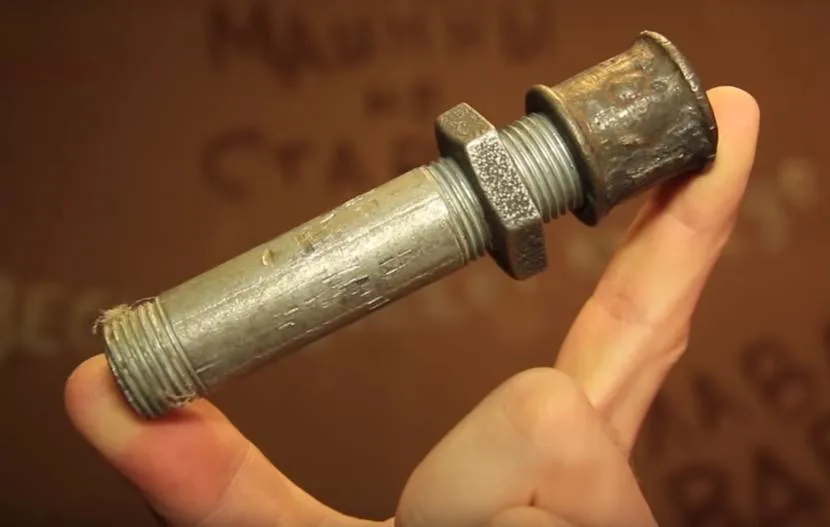
Steel squeegee with coupling Source pzo.ru
Pipe leaks at threaded connections can be avoided if preventative measures are taken. To do this, all areas with threads are coated with paint. Preferably in several layers.
How to fix a leaking fitting
Elimination of leakage of the connecting fitting is carried out according to the following scheme:
- First of all, it is necessary to tighten the threaded connection. For this:
- you will need a wrench and an adjustable wrench;
- the pipe is fixed using an adjustable wrench;
- use a wrench to tighten the fixing nut;

Tightening the threaded connection on the fitting
The thread must be tightened very carefully and slowly. Over-tightening may cause the fitting to crack.
- If tightening the thread does not help, then with a high degree of probability the problem lies in the wear of the thread or sealing material. The problem can be resolved by replacing the insulating material. For this:
- it is necessary to turn off the water supply to the residential premises. The shutdown is carried out using a tap located in the apartment (if the leak has formed on a pipe that is part of the wiring of the residential premises) or the tap of a common building riser (the tap is located in the basement);
- the thread is unscrewed completely or up to half, depending on the complexity of the situation;
- the old sealing layer is removed;
- new insulating material is wrapped;

Applying linen thread to thread
- the fitting is installed in its original place;
- If the above measures do not allow you to seal the leak in the pipe, then the fitting will need to be replaced. Replacement of the connecting element is carried out as follows:
- the old fitting is removed. If the connection is threaded, then simply unscrew the thread. If a permanent fitting is used (welded or compression), then it is necessary to cut off the connecting element;
- a new element of the plumbing system is being installed. The threaded fitting is screwed into the old place. To install a welded or compression fitting, you will need special equipment (a welding machine or a press device).

Installing the compression connector
When replacing one-piece fittings, it should be taken into account that the total length of the pipeline will need to be increased, which is done by inserting an additional section of pipe. It is better to entrust the replacement of welded and compression fittings to professionals.
All methods for eliminating pressure leaks
Let's look at how to seal a leak in a water pipe under pressure. The truth should be stated. All of the methods listed below are essentially temporary. But in real life, if such a patch is installed with the utmost quality, it will easily last for several years.
Clamp
The method has been widespread since very ancient times. You can make a pipe clamp to eliminate a leak yourself from a suitable galvanized strip. Or use a ready-made factory product. In both cases, the patch turns out to be of high quality. In some old apartments you can see pipe clamps installed by Soviet plumbers.
Thick rubber is applied to the leak site. You can even wrap a piece of a bicycle inner tube in several layers. And a clamp with a bolted connection is installed on top, which is tightened tightly.
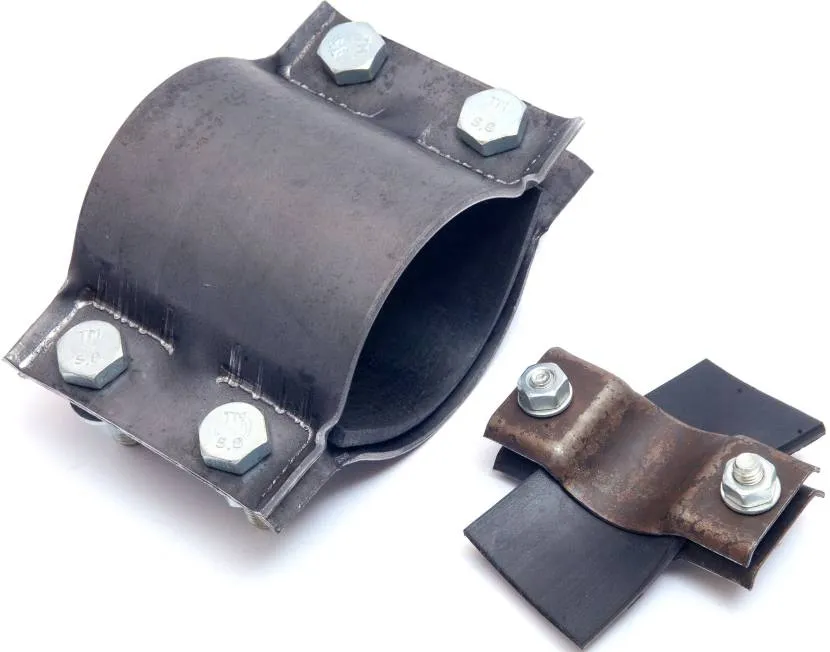
Repair clamp Source gkh-market.ru
Self-tapping screw
Let's consider how to repair a hole in a cold water pipe if you don't have a clamp at hand. When the fistula is still very small, you can use special roofing fittings. Such a self-tapping screw for fastening sheet material on the roof of a house has at its end a nozzle for drilling metal. And under its cap there is always a rubberized press washer.
The self-tapping screw is screwed tightly into the leak area. And although there are many cases where such repairs take years, it is better to patch leaky pipes better over time. The main disadvantage is the fact that the part of the self-tapping screw that is located inside the pipe causes inevitable blockages.
See also: Catalog of companies that specialize in engineering systems (heating, water supply, sewerage and others) and related work
Cement
This method will allow you to seal a leak in a pipe if the water pressure is low. Regular cement mortar is mixed. A medical bandage is impregnated with it, which is tightly wound in several layers at the accident site. Then everything is well coated on top with a thicker solution.
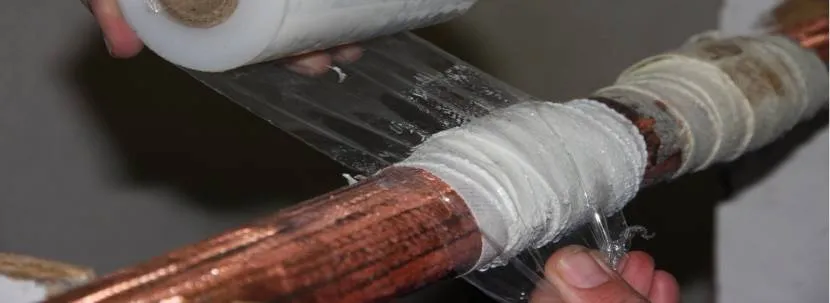
Bandaged emergency pipe Source jettwrap.co.za
Glue
You can seal the water pipe with a special glue based on epoxy resin with metal dust. But it is very difficult to do this under pressure. After all, it is necessary to thoroughly clean the repair site. Therefore, they go two ways. Either use a bandage soaked in glue, or turn off the water and let the glue patch dry.
Why do pipes wear out?
For the installation of heating systems in residential buildings and apartments, metal pipes and radiators are most often used. They are highly wear-resistant, have a long service life, and high heat transfer. But even the most wear-resistant structures have a limit of strength and lifespan.

Steel heating radiator
Most often, leaks occur on metal pipes and batteries. Possible causes of wear
:
- Aggressive coolant environment and external factors causing metal corrosion. This process occurs due to condensate entering hard-to-reach and unprotected areas and contributes to the gradual destruction of the walls.
- Factory defects - to protect yourself from purchasing such products, ask the seller for a quality certificate with a Quality Control Department stamp.
- Long service life and mechanical damage. No matter how strong the metal is, it cannot withstand constant increased physical and mechanical loads. The equipment is constantly under high pressure, so it gradually becomes thinner and wears out.
- Incorrect insertion, violation of threaded connections, installation technologies. The most vulnerable places where water leaks most often are welds, joints, threaded connections and the areas around them.
- Violation of the normal operating mode: the cause of a battery breakthrough can be excessive or, conversely, insufficient pressure in the system, as well as a violation of the operating mode.
Leak in the heating system
All of the methods described above are well suited when the question arises of how to seal a leak in a heating pipe under pressure without welding. But if there is no glue or cement at hand, and a clamp or self-tapping screw cannot be used, then for a few days you can use the old-fashioned method. Just remember that such a patch will not last long.
The accident site is wrapped with a bandage or gauze. But each layer at the site of the fistula is well covered with ordinary table salt. You can even add a little water to it to make a coating. The winding needs to be made as thick as possible - up to one and a half centimeters.
The salt will coke the hole. But water will dissolve it in a few days. Therefore, you need to immediately prepare for more serious repairs.
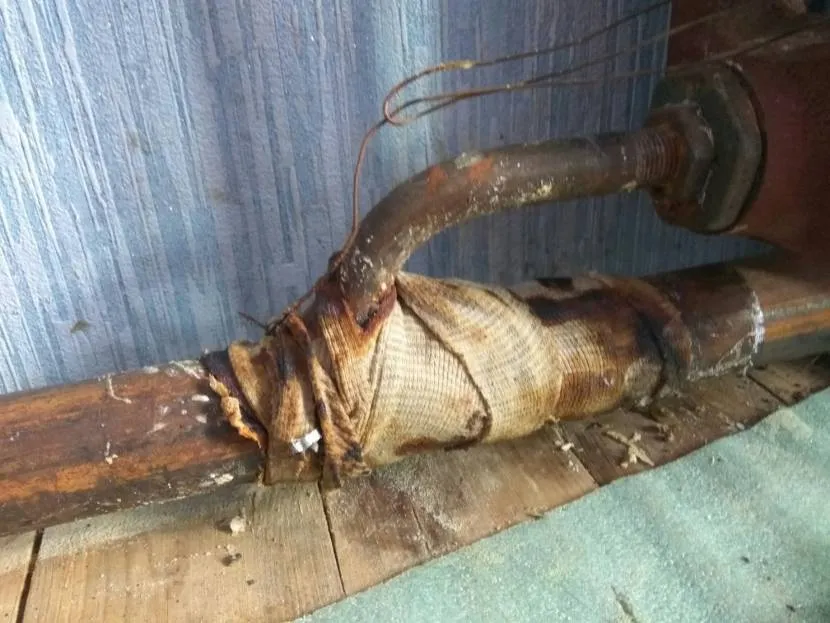
Pipe repair with salt Source b-online.ru
Radiator plate leak
The problem with plate radiators is the thin metal, which is susceptible to corrosion, and over time fistulas can appear in it. In this case, cold welding is needed.
You need to drain the water, clean the leak area from rust and paint, and then degrease it. Then apply glue following the instructions. After the glue has hardened, this is about 30 minutes, you can start the risers, not forgetting to bleed the air.
Working with plastic pipes
Although the plastic system is considered the most reliable, unexpected failures can still occur. Typically, leaks occur at fittings. In this case, it is necessary to tighten the connections very carefully. Excessive force may result in a more serious accident.
When the entire plastic system is soldered, it is best to seal the ruptures in the pipe with epoxy compounds. In this case, you can use regular glue. Free from metal dust. You can use a medical bandage.
You can also seal a hole in a water pipe in a plastic line using regular electrical tape. True, such repairs will not last long, but as a temporary measure they will justify themselves. You need to choose a very elastic (fresh) electrical tape. If it breaks, it no longer fits.
Alternatively, you can consider the artisanal soldering method. It lies in the fact that there is no need for a special apparatus. It is enough to heat a steel nail well and use it to melt the plastic at the accident site. Some craftsmen make such repairs even with the help of an ordinary lighter or matches.

Hot nail Source mirwellness.com
Chemical methods to combat leaks
Such repair of water pipes without welding involves the use of various chemical compounds.
Metal polymer "Emergency"
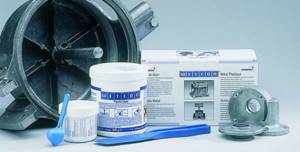
Another name for this product is epoxy composite. This is a professional putty mixture that allows you to quickly and reliably eliminate any small leak. It consists of metal dust, which is mixed with epoxy resin.
Various fillers are used: there are metal polymers with aluminum, bronze, steel, titanium. There are compositions with minerals - with carborundum or zircon. Before repair, the components are connected and quickly applied to the damaged area. The layer thickness is 10 mm. This putty hardens in 24 hours. Mechanical processing of dried metal polymer is permitted.
Silicone and paint mesh
Often sealants become saviors. More specifically, one type of them is silicone-based. Its advantages are increased wear resistance and the ability to withstand maximum temperatures (up to 350°) without problems. The second required element is a painting cloth made of fiberglass.
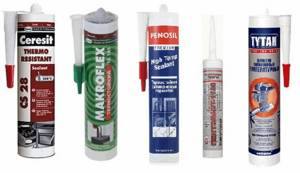
Repairing water pipes without welding consists of several stages.
- First, the damaged surface is cleaned, then a thin layer of sealant is applied to the area: no more than 2-3 mm.
- Then the painting cloth is wound around the pipe section, end to end. After this, a layer of sealant is applied again, and then the reinforcing material is screwed in, but with a larger overlap: the overlap on the turns is 5 mm.
The total recommended number of layers is at least 4. The fabric is wound as tightly as possible. The last layer is always sealant. The pipe section must dry, but the time required for such a dressing to dry depends on the type of sealant. Some compounds dry in a few hours, others take a day or more.
Superglue and soda: for any pipes

This successful "duet" is universal, as it can be used for plastic and metal water pipes. However, there are mandatory conditions: damage to the area should be minimal, the surface requires high-quality pre-treatment. First, the problem area is cleaned with a file (grinder), then dirt and dust are removed, and degreased with any solvent.
- The first layer of painting cloth is wrapped around the damaged area. A layer of baking soda is applied to it.
- Then this operation is repeated two more times, since 3 layers of fabric/soda are needed.
- The last stage is applying glue. For example, with a small spatula.
Leaking hidden pipes
If the line is hidden in the wall or under the floor, then you should not rush to break the partitions to eliminate the leak. If the fistulas are still very small, perhaps you can save yourself from trouble with the help of ordinary mustard. But you just need its dry powder.
Literally 100 grams of the mixture must be poured into the expansion tank of the heating system. After just a couple of hours, all small holes will be closed. But the water in the main must be changed to fresh the very next day. Otherwise there is a risk of filter clogging.
You can use a special factory sealant. The principle of action is the same as that of mustard. Moreover, such a powder is suitable if antifreeze circulates in the system. But the water also needs to be changed within a day.
When to start repairing heating pipes
If you find a leak in your heating pipes, you need to start solving the problem immediately before it becomes more widespread, regardless of the season. It is much better if the breakdown is detected in the summer - then you can immediately make a full repair of the leak by replacing a section of the pipe or the entire system. It would be nice if morally and physically obsolete heating pipes are replaced with new ones made of reinforced polypropylene. Although, of course, everything depends on the available budget.
Rehau pipes can be a good choice for laying a heating system. These products are optimally suited for use in domestic apartments and, with skillful installation and use, practically do not cause problems.
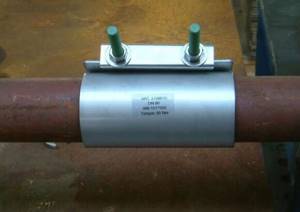
It is worth noting that although it is more convenient to repair the heating system in the summer, if a leak is detected during the heating season, you need to urgently begin to fix it, without waiting for warmer weather. Any repair work, even temporary, must be carried out in a short time.
Please note that in order to avoid troubles with pipe leaks in winter and not be left without heat, as well as to protect your property and family budget, it is necessary to regularly diagnose all heating communications in order to eliminate any problems in a timely manner.
Briefly about the main thing
There is a saying that nothing is more permanent than temporary. Based on this, to quickly repair a water main that is under pressure, it is necessary to choose a reliable method. The best option is to install a clamp attached to a piece of rubber.
But if it is not at hand, then the accident site can be wrapped with a bandage. The gauze material is pre-impregnated with either ordinary cement mortar or epoxy adhesive. As a very temporary measure, in the absence of the above mixtures, ordinary table salt will work.
If the fistula is very small, then you can screw a special roofing screw into it. It has a rubberized washer that will tightly plug the breakout site.
A hole in a plastic pipe can be sealed using an open flame. The edges of the hole are carefully melted and the gap is closed.
Ratings 0
Mechanical methods of pipeline repair
These methods are quite numerous, since craftsmen successfully use various available materials.
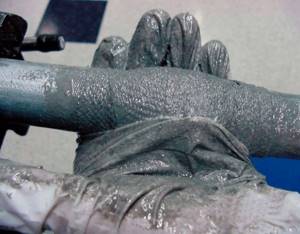
Medical bandage and cement
This is the simplest option if the “appearance” of the pipe is not nearly as important as its tightness. In this case, the operation consists of simple steps:
- first the bandage is cut into pieces, then a not too thick cement mortar is made;
- strips of material are thoroughly impregnated with the mixture, after which they are quickly wound around the damaged area.
The resulting cocoon is again coated with the solution, then left to dry. Such an almost “concrete structure” dries out in about a day. The finished patch is painted.
Help with self-tapping screws and bolts for metal products
This is another popular option when considering repairing water pipes without welding. It is suitable if the thickness of the metal walls is more than 3 mm, and the diameter of the hole that appears is no more than the same 3 mm (maximum 4 mm). The role of the “plug” is played by ordinary galvanized self-tapping screws, supplemented with a rubber washer. The operation is quite simple:
What type of sealant can you choose?
Heating system elements can be connected in several ways. They can be securely fastened by welding, but in this case there is no possibility of disassembling the structure if necessary. The use of flange connections is not always convenient and is more common when installing heating plant elements. The most popular is the threaded connection, which is the easiest to assemble, but necessarily requires the use of seals, which can be divided into several categories based on their composition:
- Solid, including various washers and rings;
- Elastic, made from fabrics or threads;
- Liquid or viscous compositions.
Each type of sealant has its own advantages and features of use.
Radiator leak between sections
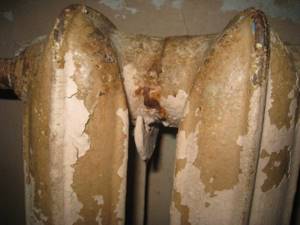
The reason may be a change in the temperature of the coolant, namely its decrease. To eliminate this problem, you need to drain the water from the risers. Next, the radiator is disconnected and removed. The next step is to determine the distance between the location of the damage and the end of the heating device, which is closest. Then you need to run the radiator key into it. This is done in order to hook the nipple and tighten it. Which way it screws depends on which side the key is inserted from. Connecting the heating device to the riser and starting it can be done after the blind plugs have been screwed in, and do not forget to bleed the air.
https://youtu.be/feUd3bbXZH4
The choice depends on the type of pipe
You can also simply fix the leak with epoxy glue. Plastic or fiberglass is selected as a bandage. The previously damaged area is thoroughly dried and cleaned. If the choice is fiberglass, then at least five turns around the pipe will be required. The width of the patch is measured according to the diameter of the pipe; it must be at least 1.5 units.
Glue must be applied to the bandage, which is subsequently pressed using clamps. Before starting the system, you need to wait a certain amount of time for the epoxy glue to dry thoroughly, that is, at least a day at a temperature of 15 degrees Celsius.
Prevention
Leaking heating system pipes are easier to prevent than to correct the situation later. To avoid such a situation, only suitable materials are used for the construction. This applies to plastic pipes.
For the heating system, only special materials are used, and not pipes for cold water. To avoid leaks, the condition of the pipes is also regularly assessed. If the slightest defect is detected, it is recommended to replace the material.
When a heating system pipe leaks, it is advisable to repair the defect immediately. If timely measures are not taken, this will lead to pipe bursting.
Sealing tapes
These innovative products have anti-corrosion properties. They consist of a bitumen-rubber base with the addition of a layer of aluminum (or copper). The greatest efficiency of using self-adhesive tapes is achieved when sealing the joints of sewer structures.
Positive characteristics of sealing tapes:
- ease of use;
- strength;
- long operational period;
- providing dielectric and anti-corrosion protection of pipes.
The only drawback of the material is rapid deterioration when exposed to sunlight. This “minus” of the product does not in any way affect the elimination of pipe defects. Indeed, in most cases, the sewer system is located away from exposure to ultraviolet radiation. If the pipes are located in an open space, then when sealing holes and cracks, the self-adhesive tape is additionally covered with a protective material.
The process of using tape consists of the following steps:
- the damaged surface is cleaned of dirt and dust;
- after the surface has dried, the protective film is removed from the tape;
- the tape is wrapped around the pipe.
The tape is wrapped in a spiral with an overlap of up to 50%. As a result, the entire pipe will be covered with two layers of material. When tensioning the tape, it is necessary to avoid the appearance of wrinkles.


